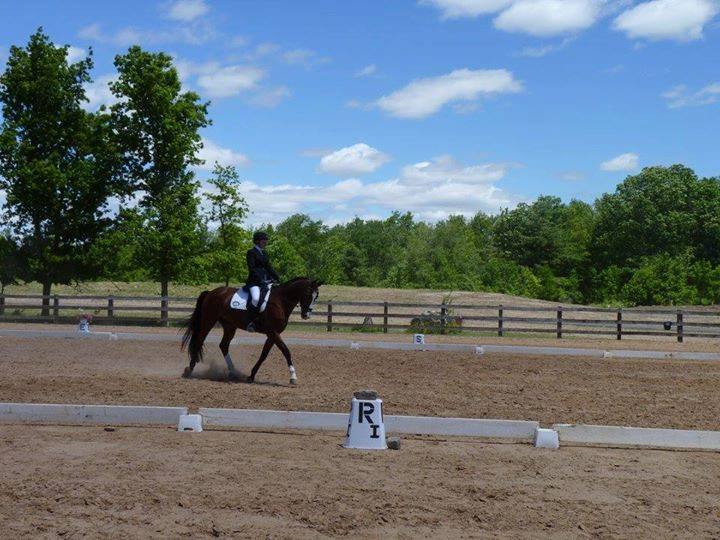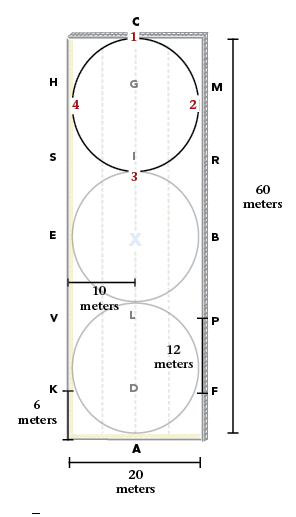This picture shows Amanda Peer of Canada riding her 14-year-old Oldenburg gelding, Caliente. They have competed through First Level and are now training and working toward Second Level for the upcoming season. Amanda writes that she has some back issues and is working with different treatments and therapies to improve her core. She also says that learning and understanding more about rider biomechanics has been very helpful for her.
As far as I can tell from the picture, Caliente appears to be an elegant horse with nice long legs. He seems to be very willing and it looks like he and Amanda trust each other and enjoy working together.

In this moment of the picture, Caliente is trotting down the diagonal of the arena. From this angle, it is a bit difficult to judge his true activity from behind, as often this perspective can change the visual proportions.
Caliente’s frame looks appropriate for a First Level test and it does look as if he could carry himself a bit more for Second Level, too. His nose is a bit behind the vertical line and my impression is that with a little more activity from behind, the movement can come more through his back and then he will be able to better reach forward into the contact with his neck. My impression is also confirmed by the amount of dust that his hind legs create, as if he is dragging them and not using them actively enough.
Amanda’s seat looks correct in the basic outline. It appears that she is attempting to sit as relaxed as possible, but by this is actually a bit too passive, which does not help improve her horse’s gaits or his frame. I get this impression because her leg position shows a slight outward rotation in her hips: her legs just hang down. Her pelvis appears to be balanced on top of the horse but is not deeply connected into his movement. I can also see that she is glancing down at his neck, which always weakens the basic tonus and reaction time of the abdominal muscle chain.
If I were to plan a lesson for Amanda based on this photo, my list of goals for her would include: building core stability without becoming stiff, differentiating between positive and negative tension in her body and then using this to influence the horse.
First, I would ask her to find a forward seat (jumping position) while trotting. As she balances her seat like this, she should concentrate on feeling the exact moment the horse’s hooves land on the ground. If she is passively balanced, she will feel that the horse lands very shortly before she can feel her own weight landing in her knees and stirrups. In an actively balanced seat, she and the horse should land with exactly the same timing.
Why is this so important? If you have ever jumped on a big trampoline at the same time as a friend and you do not land in a synchronized way, you will probably start to annoy each other. But, on the other hand, if your landing is timed together, you can easily jump much higher.
Therefore, you can see how simply timing your own body weight to feel and react to the rhythm of the horse is an aid for the horse to lift off the ground with more activity.
Feeling this active balance needs to continue when performing rising and sitting trot. This does not mean landing hard on the horse’s back. It means controlling your balance and synchronizing it with his movement.
We have several different phrases that we use in riding to describe this concept. Some say “connecting deeper with your horse,” “becoming one with the horse’s movement” or “melting together with the horse.” They all describe this same idea.
To work toward the collection that Caliente will need as he progresses up the levels, he must stretch more through his back and topline.
Notice how the horse’s topline is mirrored in the rider’s back line. Demanding more elasticity in both horse and rider means there is a need for more stability and more stretch.If you think of the way a rubber band works, you know you can increase the elasticity by stretching it apart. Stability needs length and stretching up needs grounding, which starts from the seatbones and is secured by the long dressage leg. This is called creating stability through contrast.
In physiotherapy, you hear and read more and more about body fascia, which is a tissue that connects all muscles and organs through the whole body.
For Amanda, I would like to point out the importance of the long dorsal fascia. This fascia starts at her eyebrows, runs over her head, down her neck and spine, along the back of her legs around the ankles, underneath her feet and to the big toe.
This fascia gets stretched and stabilized by stretching the back of her neck up and reaching long in her legs while lifting her toes a bit up. Once her back line is stable, it allows Amanda’s hands to move forward while she maintains her core stability. At the same time, Caliente can feel more stability for his back and topline and dare to reach out longer with his neck without losing the balance in his hind end.
The image that more stability and more collection require expansion of the seat and topline (never shortening!) is an important tool for Amanda and Caliente to remember on their way up the levels.
The easiest way to distinguish between positive and negative tension is that positive tension expands. It makes the body longer, while negative tension shrinks and shortens. More collection requires and reflects more positive tension.
To avoid stiffness, try this: While riding, work at rhythmically stretching up and then always returning to your comfort zone, or what we’ll refer to as the “middle” position. If you sit in an upright position, you can play with the length of your upper body.
While your head should stay over your pelvis, you can shrink yourself by giving up tension and collapsing a bit, or you can grow, creating positive tension by lengthening and stretching through your spine.
Start in the middle, or comfort zone, position and then play between the shrinking, middle and stretching positions. Think: shrink–middle–stretch–middle–shrink. Later, you can cut out the shrinking position and then you can just alternate between the stretching and middle positions.
This is a good way to improve your ability to stretch up, as this way you do not tire out and you avoid the stiffness that occurs when you work at the physical limits of your movement. In this way, you should be able to stay elastic or dynamic within your stability.
Working at the limit of your stretching ability will not allow true suppleness, so do this exercise gradually. Think about stretching up, releasing a bit and stretching more. Remember to do this in active balance with your horse’s movement.
This will be very helpful for Amanda to improve the collection within her own seat and help Caliente in this, too.
I hope that Amanda can use these images, tools and tips to continue her journey with Caliente through the adventure of dressage.
Susanne von Dietze is a leader in equestrian biomechanics. A physiotherapist, licensed Trainer A instructor and judge for dressage and show jumping, she gives lectures and seminars throughout the world, including at the prestigious German Riding Academy in Warendorf. She is a native of Germany and now lives with her husband and three children in Israel, where she competes at the international level. She is the author of two books on the biomechanics of riding: Balance in Movement and Horse and Rider, Back to Back. Find her books at www.EquineNetworkStore.com.
Send Your Photo!
You can submit your high-resolution dressage photo for critique (300 dpi and 4 by 6 inches in size). Or you can send your photo with a link to a short video. Email to DressageToday@aimmedia.com. Turnout in dressage show or clinic-appropriate attire is encouraged. Don’t forget your helmet!











